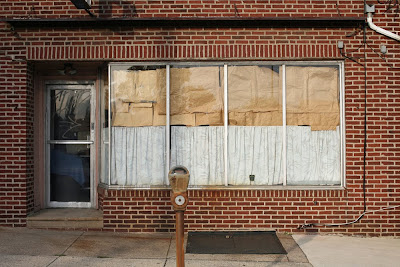 rhawn street. philadelphia 2010
rhawn street. philadelphia 2010

While I can point to specific non-fiction books as being highly influential on my photography work (see Bibliography), literary fiction has been equally if not more influential on my work, but in a general macro sense. My favorite genre is the short story, and I have read hundreds if not thousands of short stories over the years. To me they are like paintings or sculptures, some of the best are not fully appreciated until after a third or fourth reading. I have been buying the Best American Short Story series for years now and I have started collecting the older editions; the series started in 1978. My goal is to collect the complete set.
It's a fairly elitist selection every year, and the same authors seem to show up on a consistent basis, but certainly no different than any best of selection in the art world, and certainly no different than the elitist nature of the contemporary photography world. But there is no disputing the quality of the choices, and while I have my individual favorites, it is the genre of contemporary American realist fiction itself that captivates me. I have read some of my favorite stories dozens of times over the years. (Just look at the tattered condition of the 1996 edition) They are like paintings that I can return to over and over again. They shape the way I view the world.
Plastic Unreality-
Christopher Alexander
A Pattern Language
In the modern city industry gets treated like a disease. The areas where it exists are assumed to be dirty and derelict. They are kept to the "other side of the tracks," swept under the rug. And people forget altogether that the things which surround them in their daily lives- bread, chemicals, cars, oil, gaskets, radios, chairs- are all made in these forbidden industrial zones. Under these conditions it is not surprising that people treat life as an unreal charade, and forget the simplest realities and facts of their existence.
Since the 1930's various efforts have been made, on behalf of the workers, to make factories green and pleasant. This social welfare approach to the nature of industries is once again unreal, in the opposite direction. A workshop, where things are being made, is not a garden or hospital. The gardens which surround the new industrial "parks" are more for show than for the workers anyway since a few inner courts or gardens would be far more useful to the workers themselves. And the contribution of an industrial park to the social and emotional life of the surrounding city is almost nil.
Christopher Alexander
A Pattern Language
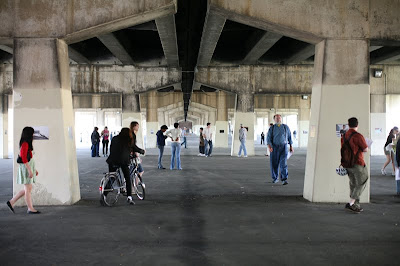 Under I95. 2008
Under I95. 2008Zoe Strauss Under I-95
Philadelphia Museum of Art
January through March 2012
Zoe Strauss Under I-95 is a mid-career retrospective of the acclaimed
photographer¹s work and the first critical assessment of her 10-year project
to exhibit photographs annually in a space beneath a section of
Interstate-95 in South Philadelphia. Strauss¹s subjects are broad but her
primary focus is on working-class America. Many of her pictures depict
down-and-out people and landscapes, offering a poignant, troubling portrait
of contemporary American life, frequently featuring people and places from
the surrounding neighborhoods, similar districts in other American cities,
as well as suburban and rural places in between.
Untrained as a photographer or artist, Strauss founded the Philadelphia
Public Art Project in 1995 with the objective of exhibiting art in
nontraditional venues. She turned to the camera in 2000 as the most direct
instrument to represent her chosen subjects. In 2006, Strauss participated
in the Whitney Biennial and in 2008 she published her first book, America.
In 2012 she's going to bring it with a full throttle solo exhibition at the
Philadelphia Museum of Art. Mark your calendars and set your sights high.
Curator: Peter Barberie, The Brodsky Curator of Photographs, Alfred
Stieglitz Center
 popeye's chicken. 2010
popeye's chicken. 2010Missoula Art Museum
39th Annual Benefit Auction and Exhibit
January 7th - February 3rd, 2011
Natural Symbolism-
- Charles B. Wheeler
The Design of Poetry
This kind of symbolism is natural because it is found in nature and because the objects which have symbolic meaning are thought to have it naturally and inherently, not depending on the human mind to give it to them. One of the classic statements of this position is Emerson's: "It is not words only that are emblematic; it is things which are emblematic. Every natural fact is a symbol of some spiritual fact." The notion is attractive, it suggests that man does not inhabit a blank and irrelevant universe, but one which is somehow congenial to him, reflecting his mind in its own structure and its component parts, providing incessant material analogies to the human spirit. The visible surface of nature is eloquent. As Emerson goes on to say, "Who looks upon a river in a meditative hour and is not reminded of the flux of all things? Throw a stone into a stream, and the circles that propagate themselves are the beautiful types of all influence." The mountains seem to speak of aspiration and nobility, sunrise and sunset of birth and death, the stars of permanence and order. There are sermons in stone, books in the running brooks. Attractive though it may be, the existence of a natural symbolism has to remain a matter of faith alone, since the conditions for submitting it to proof are nearly impossible to obtain. In order to prove it one would have to find a person whose mind was uncontaminated by any previous notions of natural symbolism, explain to him somehow, without predudicing the experiment, what one was trying to do, and then confront him with an allegedly symbolic natural object to see whether he would spontaneously find meaning in it. What actually happens is that we are already conditioned to see certain meanings in objects by our cultural tradition, meanings that have been read into, not out of, these objects.
- Charles B. Wheeler
The Design of Poetry
Many thanks to Willson Cummer, editor of the wonderful blog New Landscape Photography, for introducing me to the work of J Bennett Fitts. Willson made the suggestion because Fitts is a photographer who draws influence from the vision of Lewis Baltz. I'm especially drawn to the series Industrial Landscape(ing), of which the two images below are from.
 J Bennett Fitts. one tree two bushes
J Bennett Fitts. one tree two bushes
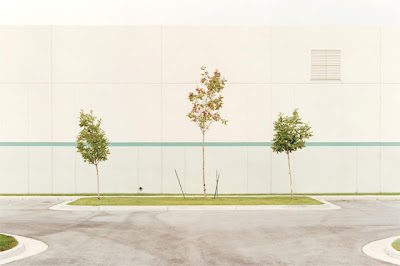 J Bennett Fitts. symmetrical trees
J Bennett Fitts. symmetrical trees
New Landscape Photography
J Bennett Fitts
 J Bennett Fitts. one tree two bushes
J Bennett Fitts. one tree two bushes J Bennett Fitts. symmetrical trees
J Bennett Fitts. symmetrical treesNew Landscape Photography
J Bennett Fitts
"Our society really left home when we placed boundaries between ourselves and the earth, when we moved en mass inside totally artificial, reconstructed, mediated worlds- huge concrete cities and suburbs- and we aggressively ripped up and redesigned the natural world. By now, nature has literally receded from our view and diminished in size. We have lost contact with our roots. As a culture, we don't know where we came from; we're not aware we are part of something larger than ourselves. Nor can we easily find places that reveal natural processes still at work".
- Jerry Mander
In the Absence of the Sacred
Landscape is an active principle.Its existence is the result of human actions and natural processes in ever-changing combinations, and its understanding requires that the senses, the mind, and the imagination be fully engaged with the facts in front of us. My study of landscape began when I asked, "Why do these things look the way they do?"
Thoughts on Landscape
Frank Gohlke
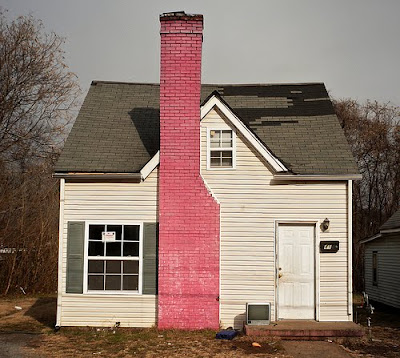 Pink Chimney & TV by Ronny Perry
Pink Chimney & TV by Ronny PerrySaw this pop up on Ronny Perry's Flickr today and I keep going back to look at it again and again. A foreclosed house in Murfreesboro, Tennessee. It's a really cool blend of Walker Evans and William Christenberry
Written in 1903 to an aspiring poet, I think this is perfect advice for the aspiring artist of any medium, including photographers...
- Letters to a Young Poet
Rainer Maria Rilke
This above all- ask yourself in the stillest hour of the night, must I write? Delve into yourself for a deep answer. And if this should be affirmative, if you may meet this earnest question with a strong and simple "I must", then build your life according to this necessity; your life even into its most indifferent and slightest hour must be a sign of this urge and a testimony to it. Then draw near to nature. Then try, like some first human being, to say what you see and experience and love and lose. Do not write love-poems; avoid at first those forms that are too facile and commonplace: they are most difficult, for it takes a great, fully matured power to give something of your own where good and even excellent traditions come to mind in quantity. Therefore save yourself from these general themes and seek those which your own everyday life offers you; describe your sorrows and desires, passing thoughts and the belief in some sort of beauty- describe all these with loving, quiet, humble sincerity, and use, to express yourself, the things in your environment, the images from your dreams, and the objects of your memory. If your daily life seems poor, do not blame it; blame yourself, tell yourself that you are not poet enough to call forth its riches; for to the creator there is no poverty and no poor indifferent place.
- Letters to a Young Poet
Rainer Maria Rilke
In the past two months I have had seven portfolio reviews. In October I participated in a triple review at Hous Projects in New York City where I got one hour reviews from Elizabeth Houston, Ruben Natal-San Miguel, and Mike Mao. In November I participated in another triple review at InVision Photography Festival in Bethlehem, Pa. that included 30 minute reviews with Alex & Rebecca Webb, Ricardo Viera, and Larry Fink. And as a grand finale, in December I participated in a workshop at Project Basho in Philadelphia called The Emotional Lens that was led by Larry Fink. Seven participants were engaged in a ten hour long intensive group portfolio review.
Prior to October, I had never had a formal review of my work, and now two months later I feel like a seasoned veteran. I was extremely nervous going into my first reviews at Hous Projects, and now I feel like I would be willing to show my work to anyone. The review process was invaluable to me in many ways, and I think that doing multiple sessions over a relatively short time span is something I will consider doing on an annual basis if I have the opportunity.
I was forced to really think about consolidating a cohesive body of work for the first time. Like many photographers I tend to shoot just about everything I see in a wide variety of formats, and this ends up being a scattered and chaotic pile of images in a multitude of archival storage boxes, folios, and internet photo sites. There is nothing wrong with that, but I couldn't possibly take a representation of all of my infinite photography genres to a thirty minute review. Preparing for a formal portfolio review made me narrow down into sharp focus what really matters to me as a photographer. What is at the core of thisinsane intense passion that consumes me on a daily basis, and what is really worthy of putting out there for honest and raw scrutiny ?
What did I learn? Too many things to mention or remember here in one sitting, but several key things. First, the importance of the document; the print itself. I am so accustomed to looking at my work and the work of others via the computer and internet sites that it becomes the visual norm. Electronic photography becomes my basis for aesthetic judgement and critical assessment and that is not the way it should be. The carefully printed tangible photograph observed under ideal lighting adds a tactile level of experience never found on the computer screen. The one on one dialog between photographer and reviewer standing in front of the actual printed image; picking it up, turning it around, moving it on the table among the other images is entirely different than two people sitting in front of one computer screen scrolling through images. I now have a completely new appreciation and respect for my archival storage box containing my carefully selected and reviewed portfolio of images.
Second, and probably the most significant thing I got from these reviews was a sense of my work being credible; a validation that I was making a cogent expression of ideas. Not every reviewer was excited about my work, but even when I sensed indifference to my subject matter, it was still clear to me that my message was being felt. That is the most important aspect of my personal working style, and I walked away from each review with not just confirmation of the message being heard, but also suggestions of ways to improve upon the methods of telling. Simple comments or questions about my work would immediately get scribbled into my notebook as the review was taking place. Alex Webb asked me if I knew the work of Lewis Baltz. I told him I had heard the name but didn't know of his work. He suggested I look it up and I was astonished to find this work that Baltz did in the mid 1970's of New Industrial Parks. I have no conscious memory of seeing this work before but I have to wonder if it has been in my subconscious from many years ago. (Baltz was capturing the birth of this architectural style, while I am now documenting its death ?)



Lewis Baltz Archive
Another strong validation for me was that the majority of the reviewers made a connection to the underlying gut feelings of my imagery, without any verbal context from me.. Ricardo Viera called them 'emotional abstracts' , and Larry Fink referred to them as 'poetry' and called me a 'poet'. Highly satisfying considering that I have written and meditated on the connection between photography and poetry many times.
Photography & Poetry
Photography & Poetry
Moving forward, I will go back to what I stated earlier about feeling like a seasoned veteran of the review process. What I mean by that is I think I gained a sense of maturity; a small leap in overcoming the ignorance of 'not knowing what you don't know' prior to a new learning experience. I think I have a better sense of 'what I don't know' about my work. The reviewers have pushed me towards a place beyond where I might have imagined I was headed. I have no idea where that place may be, but I have discovered that the portfolio review is an essential element for me in moving forward as an artist. I want it to become an annual occurrence.
Reviewers
Ruben Natal San-Miguel
Elizabeth Houston
Mike Mao
Alex Webb
Rebecca Norris Webb
Ricardo Viera
Larry Fink
A few tips for a successful portfolio review
Prior to October, I had never had a formal review of my work, and now two months later I feel like a seasoned veteran. I was extremely nervous going into my first reviews at Hous Projects, and now I feel like I would be willing to show my work to anyone. The review process was invaluable to me in many ways, and I think that doing multiple sessions over a relatively short time span is something I will consider doing on an annual basis if I have the opportunity.
I was forced to really think about consolidating a cohesive body of work for the first time. Like many photographers I tend to shoot just about everything I see in a wide variety of formats, and this ends up being a scattered and chaotic pile of images in a multitude of archival storage boxes, folios, and internet photo sites. There is nothing wrong with that, but I couldn't possibly take a representation of all of my infinite photography genres to a thirty minute review. Preparing for a formal portfolio review made me narrow down into sharp focus what really matters to me as a photographer. What is at the core of this
What did I learn? Too many things to mention or remember here in one sitting, but several key things. First, the importance of the document; the print itself. I am so accustomed to looking at my work and the work of others via the computer and internet sites that it becomes the visual norm. Electronic photography becomes my basis for aesthetic judgement and critical assessment and that is not the way it should be. The carefully printed tangible photograph observed under ideal lighting adds a tactile level of experience never found on the computer screen. The one on one dialog between photographer and reviewer standing in front of the actual printed image; picking it up, turning it around, moving it on the table among the other images is entirely different than two people sitting in front of one computer screen scrolling through images. I now have a completely new appreciation and respect for my archival storage box containing my carefully selected and reviewed portfolio of images.
Second, and probably the most significant thing I got from these reviews was a sense of my work being credible; a validation that I was making a cogent expression of ideas. Not every reviewer was excited about my work, but even when I sensed indifference to my subject matter, it was still clear to me that my message was being felt. That is the most important aspect of my personal working style, and I walked away from each review with not just confirmation of the message being heard, but also suggestions of ways to improve upon the methods of telling. Simple comments or questions about my work would immediately get scribbled into my notebook as the review was taking place. Alex Webb asked me if I knew the work of Lewis Baltz. I told him I had heard the name but didn't know of his work. He suggested I look it up and I was astonished to find this work that Baltz did in the mid 1970's of New Industrial Parks. I have no conscious memory of seeing this work before but I have to wonder if it has been in my subconscious from many years ago. (Baltz was capturing the birth of this architectural style, while I am now documenting its death ?)



Lewis Baltz Archive
Another strong validation for me was that the majority of the reviewers made a connection to the underlying gut feelings of my imagery, without any verbal context from me.. Ricardo Viera called them 'emotional abstracts' , and Larry Fink referred to them as 'poetry' and called me a 'poet'. Highly satisfying considering that I have written and meditated on the connection between photography and poetry many times.
Photography & Poetry
Photography & Poetry
Moving forward, I will go back to what I stated earlier about feeling like a seasoned veteran of the review process. What I mean by that is I think I gained a sense of maturity; a small leap in overcoming the ignorance of 'not knowing what you don't know' prior to a new learning experience. I think I have a better sense of 'what I don't know' about my work. The reviewers have pushed me towards a place beyond where I might have imagined I was headed. I have no idea where that place may be, but I have discovered that the portfolio review is an essential element for me in moving forward as an artist. I want it to become an annual occurrence.
Reviewers
Ruben Natal San-Miguel
Elizabeth Houston
Mike Mao
Alex Webb
Rebecca Norris Webb
Ricardo Viera
Larry Fink
A few tips for a successful portfolio review
 Daniel Traub .Lot, North Twenty Fourth and West Master Street, North Philadelphia, 2010
Daniel Traub .Lot, North Twenty Fourth and West Master Street, North Philadelphia, 2010Daniel Traub: Lots
The Philadelphia Print Center
1614 Latimer Street
Phila. Pa 19103
December 16, 2010 - March 5, 2011
Thursday, December 16
Opening Reception: 5:30-7:30pm
Gallery Talk by the Artist: 5:30pm
The Print Center announces Lots, an exhibition of new work by Philadelphia photographer Daniel Traub. Traub has created an extensive series documenting the people and places of inner city neighborhoods in Philadelphia.
The works in the exhibition document vacant spaces between row homes. In inner city neighborhoods, houses that have fallen into disrepair or have burned are often completely razed, leaving breaks in the urban fabric. For Traub, the walls of adjoining buildings function as frames for the landscapes that have arisen in the interstitial spaces. Some are strewn with trash and debris, while others are lush and verdant. Traub's record of these spaces captures these details in a calmly objective manner, and while they are beautiful images, they are damning as a barometer of the health of a neighborhood. These works are also a revealing portrait of the artist, the son of Lily Yeh, founder of The Village of Arts and Humanities, which is renowned for its public art and reclamation projects in North Philadelphia. His father is David Traub, an architect, dedicated to the preservation of historic and vernacular buildings throughout Philadelphia.
Traub has also been engaged in long-term projects in China since 1999, exploring the transformation of China's cities through street portraits and urban scenes, as well as documenting the border regions where urban and rural China meet. Several of these works were included in the Woodmere Triennial of Contemporary Photography, Woodmere Art Museum, Philadelphia and the Art Institute of Philadelphia both in 2009.
Traub's photographs have been exhibited in Asia, Europe and the United States, including a solo exhibition at the Catherine Edelman Gallery in Chicago, and are in public and private collections including the Martin Z. Margulies collection and the San Francisco Museum of Modern Art. His work has appeared in publications including The New York Times Magazine, London Telegraph Magazine, Time Magazine and Wallpaper.
Daniel Traub: Lots will be on view at The Print Center from December 16, 2010 - March 5, 2011. The reception for the artist is Thursday, December 16 from 5:30-7:30pm, with a gallery talk by the artist at 5:30pm.
The Print Center
Daniel Traub
To let each impression and each germ of a feeling come to completion wholly in itself, in the dark, in the inexpressible, the unconscious, beyond the reach of one's own intelligence, and await with deep humility and patience the birth-hour of a new clarity: that alone is living the artist's life: in understanding as in creating.
- Letters To A Young Poet
Rainer Maria Rilke
- Letters To A Young Poet
Rainer Maria Rilke
Bibliography. (part 3)
Continuation of the books that are essential to the formation of my body of work, and the books I continuously pull off the shelf throughout the year. I go back to them again and again and rediscover something new and significant every time.



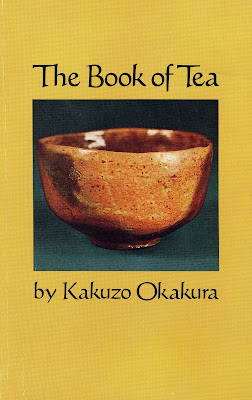
Bibliography. (part 1)
Bibliography. (part 2)
Continuation of the books that are essential to the formation of my body of work, and the books I continuously pull off the shelf throughout the year. I go back to them again and again and rediscover something new and significant every time.




Bibliography. (part 1)
Bibliography. (part 2)
 row 6 | revisited. 2010
row 6 | revisited. 2010"Teaism is a cult founded on the adoration of the beautiful among the sordid facts of everyday existence. It is essentially a worship of the Imperfect".
-The Book of Tea
It's hard to believe another year has past. This blog/project is now four years old! Many thanks to those who spend time here.
 last day of november. 2010
last day of november. 2010
 last day of november. 2010
last day of november. 2010



I've been focusing all of my energy and attention on analyzing combinations of images. I think the best way to do this is to lay out prints on a big table. Patterns of subconscious thought emerge that aren't always evident while viewing and working on single images in succession. It is very rewarding to me when a previously undisclosed connection between images suddenly reveals itself right in front of my eyes while I walk around the table.
Subscribe to:
Posts (Atom)


 moab, utah. by
moab, utah. by 







 stockburger chevrolet. 2010
stockburger chevrolet. 2010 photo by
photo by  photo by
photo by 













